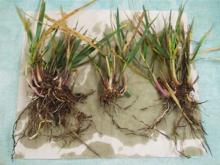Cause The fungi, Fusarium sambucinum, F. culmorum, and F. avenaceum, have been found on orchardgrass plants in Oregon seed production fields. Other Fusarium species are known to pathogenic on turf grasses: F. acuminatum, F. crookwellense, F. equiseti, F. graminearum, F. heterosporum, and F. poae, and these other fungi may be encountered in bentgrass, annual bluegrass, Kentucky bluegrass, Chewing's fescue, red fescue, tall fescue, hard fescue, annual ryegrass, and perennial ryegrass.
All of these Fusarium spp. can survive on infected grass plants, in plant residues, and some of these fungi may persist as a durable spore form in the soil. These Fusarium spp. can colonize other plant types, especially other grassy species.
Under warm, wet conditions pathogenic Fusarium spp. will produce spores, which can be moved by wind or water. Infections of root or crown may occur "rapidly" but it may be weeks or months before Fusarium crown and root rot is observed; crown and root rot are more obvious during hot, dry weather as plants die. Crown and root rot are promoted by stress, such as that caused by heat, drought, and over-application or unbalanced applications of N.
Warm, wet conditions favor leaf spot and seedling diseases when pathogenic Fusarium spp. are present. When humid conditions persist during cool weather, leaf blight may occur.
Symptoms Root and crown rot is first evident by a dry, dark brown rot in root, rhizome, stolon, or crown tissues. Affected plants turn light green then tan and finally brown as these plants die. Crown rot can lead directly to tiller death. If warm, moist conditions arrive, sometimes affected plants will exhibit whitish to pink fungal growth on the lower stem or crown. Leaf spots are not necessarily present on plants suffering from Fusarium root and crown rot but can be incited by these fungi. Leaf spots tend to develop on older leaves first. Leaf spots are usually tan or light brown and are irregular in shape. Spots can appear water-soaked with brownish-purplish borders.
Cultural control Minimizing stresses on plants will aid in managing crown and root rot. Chemical means for managing crown and root rot are not effective. Leaf spot doesn't usually require protective fungicide applications in Oregon.
- Reducing plant residues can help to decrease the pathogen population and subsequent disease. If residues are deeper than 2 inches, mechanical removal is recommended in turf situations.
- Proper applications of nitrogen (levels and balance of ingredients) can decrease rank growth and decrease problems with leaf spot, leaf blight, and rot of crowns or roots. Maintain proper soil fertility, including soil pH and available calcium, for these factors are important for vigorous root and subsequent shoot growth.
- Irrigation during dry periods should decrease crown and root rot by reducing plant stress. Water thoroughly but only as needed, avoid overwatering.

